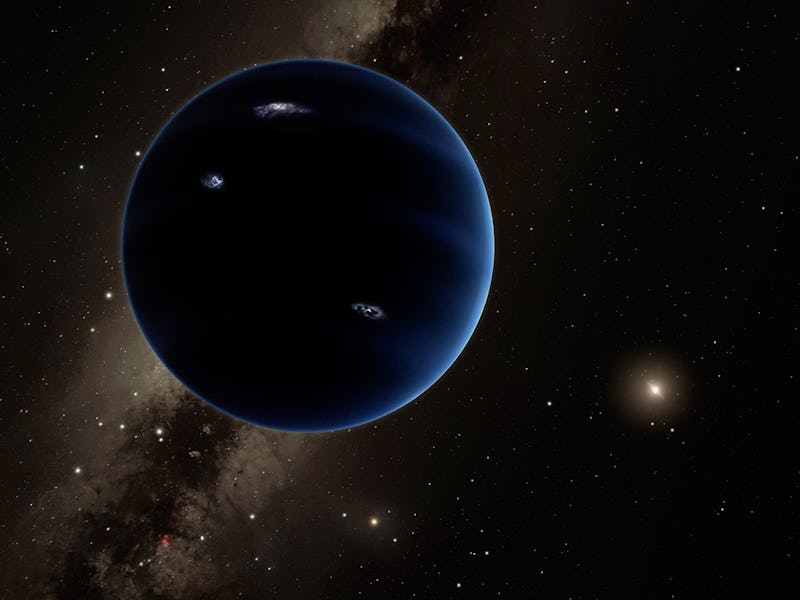Astronomers narrow in on mysterious Planet Nine’s location
"I'm sure there's something pretty big out there."

Astronomers may be on the verge of the biggest discovery in decades — a giant, ninth planet may be roaming around the far reaches of the Solar System, and they’re trying to find it.
Matthew Belyakov, a student at University of Pennsylvania’s department of physics and astronomy, has recently joined the search.
“There's always that feeling when we're analyzing any of the survey data that maybe we'll find it,” Belyakov tells Inverse. “There’s something to look forward to. It definitely gives me a bit of stimulus.”
Planet Nine is a hypothetical Neptune-sized planet that, if it exists, orbits our Sun in a highly elongated orbit that lies far beyond Pluto. In the most recent search for this mysterious object, Belyakov and his team ruled out a section of the sky where this planet may be located thus improving the odds of finding Planet Nine.
The findings are detailed in a study available on the preprint server arxiv.
What is Planet Nine?
In January 2015, a team of astronomers from the California Institute for Technology (Caltech) stumbled upon a potentially groundbreaking discovery. The alignment of several of the most distant worlds in our Solar System seemed to all have the same perihelion, or closest point to the Sun. This suggested that something big had to have pulled them into these orbits, and flung them out hundreds of times the distance between the Sun and Earth.
All this suggested a roughly Neptune-sized world so distant that it hadn’t ever been spotted. Caltech astronomers Konstantin Batygin and Michael Brown dubbed it Planet Nine. This hypothetical planet may have a mass that's about 10 times that of Earth and orbit about 20 times farther from the Sun than Neptune, the eighth and farthest known planet from the Sun. Planet Nine may take between 10,000 and 20,000 Earth years to complete one orbit around the Sun, according to NASA.
Kat Volk, associate staff scientist at the University of Arizona's Lunar and Planetary Laboratory, who was not involved in the recent study, is skeptical of Planet Nine’s existence.
“The evidence is mixed,” Volk tells Inverse. “There are disagreements about how strong the evidence is for the specific Planet Nine that has been proposed but there are definitely some interesting things going on in the most distant trans-Neptunian objects.”
Although the science community is divided on whether or not Planet Nine exists, most are united in the search for this object whether it be a Solar System planet or an odd, ginormous object lurking in the distance.
WHAT’S NEW — For the latest search efforts, the team of scientists behind the new study turned to a survey designed to find another cosmic mystery: dark energy.
The Dark Energy Survey (DES) is an international effort to map hundreds of millions of galaxies in order to reveal the nature of dark energy.
“The dark energy survey has some of the deepest resolution images, which means we can see objects that are 100 times fainter than in other surveys,” Belyakov says. “So it provides us with a much deeper coverage and we can eliminate almost all potential candidates that we've generated.”
The team generated 100,000 simulated objects that may potentially be Planet Nine based on hypothetical models of its mass and possible distance. They then looked through the data gathered by DES to see how many of these 100,000 objects it would capture.
“They injected a bunch of hypothesized Planet Nines into a model of the Solar System and asked, how many of these have been detected with the Dark Energy Survey,” Volk says. “There’s a lot of unknowns but it’s a good example of using survey data to try and find Planet Nine.”
By doing so, they were able to eliminate about 5 percent of the places in the sky covered by DES where these potential objects were not found.
“So basically, we are pretty confident we don't need to search this area again,” Belyakov says.
WHY IT MATTERS — Although it currently exists as a hypothetical ninth planet, the discovery of a new addition to the Solar System would greatly alter scientists’ understanding of how it formed.
“We would have to try to figure out how it got up there,” Volk says. “That tells us something about the formation environment of the early Solar System.”
The Solar System formed about 4.6 billion years ago, but scientists are still not sure of the details of how each planet came to be and whether our star system is unique within the universe.
“The existence of Planet Nine, if confirmed, is going to change a lot of our perceptions of how the outer reaches of our Solar System work,” Belyakov says. “[When we have] confirmed Planet Nine, we can make much more accurate predictions in terms of gravity models of the Solar System.”
WHAT’S NEXT — The search for Planet Nine continues.
The team behind the recent study are looking forward to the launch of the Rubin Observatory, which is currently under construction in Chile and expected to begin operations in 2023.The large telescope will shed light on the skies above the southern hemisphere, aiding scientists in their search and possibly ending the ongoing debate surrounding the putative ninth planet.
“I think every year that goes by, we’re getting closer to eliminating it,” Volk says. “I think we’ll get a decent answer within my career.”
“I'm sure there's something pretty big out there, I don't know if it's going to be the Planet Nine that's been predicted, but I'm sure we'll find some exciting large objects,” she adds.